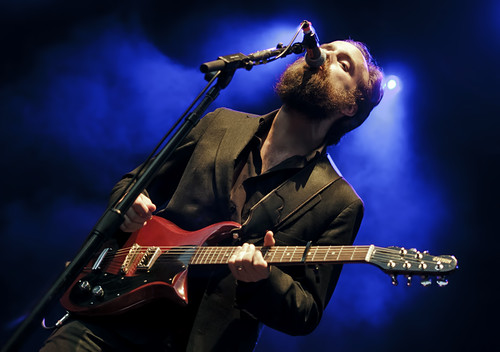One fairly frustrating thing for me when I'm photographing musicians is that they're not expressive enough. Often their lyrics say a lot, but their expressions and bodies say very little. Largely I shoot folky-type performers, and they are decidedly less expressive than, say, rock stars. And, sadly, the lighting setups for folk acts are often poor in comparison to their rock brothers'. So, to add a little
dynamism I like to add a little
wonk, and this is a common-used technique, which shows it works. For instance:

(Photo of Iron and Wine by Auteurian on Flickr)
However, you can certainly over-cook it with adding the wonk, as my top image shows. The rule of thumb here is:
If you naturally want to turn your head when you're looking at a photo, then you have bad wonk. But you'll also see that the musicians in the top photo (from a band called Eyes & No Eyes) and the Iron and Wine photo are at the same angle to the vertical... so wonk also depends on the picture. In most cases if you're heading towards an angle of 45° then you're getting perilously close to too much wonk. It helps if the focal point of your photo is higher if you have a lot of wonk... so, in the Iron and Wine photo, the guitarist's face is towards the top of the image; in my photo of Eyes & No Eyes, the focal point is Marcus' face (the guy in the white shirt), which is low in the frame, which adds to the feeling of seasickness, of being off balance.
So I managed to correct the issue by reducing the wonk (now only 30°) and moving the focal point up in the frame (to Tristram's face). Notice also now there's a nice line (perpendicular to the line of the bodies) between Marcus' eyes and Tristram's eyes, which also helps the composition.
One final thing about wonk... it's also really great for squeezing more into the frame, by utilising the diagonal. Rather than be restricted to landscape orientation (usually meaning you have to cut off somebody's legs) or portrait orientation (usually meaning you have to cut off parts of someone's guitar), using the diagonal means reducing the negatives of both options:
Of course, I've been talking about gig photography here, but adding wonk also works in other forms of photography. Just remember: don't overdo it!




No comments:
Post a Comment